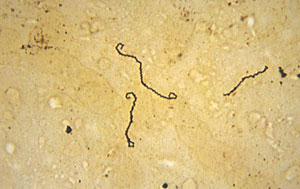 |
Twenty-five year old Ram Devi Shakya presented to a hospital with high fever, conjunctivitis, muscle pain, and breathing problems for a week. She was treated for typhoid fever, but did not improve. Meningitis was considered, but this was ruled out with appropriate tests. Her condition continued to deteriorate, and her husband agreed to pay for her blood sample to be shipped to Mumbai for further tests. The doctors continued with three new antibiotics, but to no avail. She died on the tenth day of hospitalisation. The report from Mumbai came back later with the diagnosis of Leptospirosis.
Leptospirosis comes from Greek and means finely coiled organisms (spirochetes). In a study done at Patan Hospital and published in the American Journal of Tropical Medicine and Hygiene in 2004, leptospirosis ranked fourth (after typhoid, typhus and pneumococcal pneumonia ) as the cause of fever in over 800 consecutively admitted hospital patients. And yet for some reason this disease is under-emphasised in medical colleges and residency programs here. Many doctors in Nepal and India fail to consider leptospirosis in the differential diagnosis of fever.
Leptospires are organisms which persist in the kidneys of rats and other animals. Humans may be infected with rat urine. Exposure to rat urine ( for example from puddles of water on the roadside) through an abrasion on the skin followed by flu-like illness approximately one week later is typical of leptospirosis. Many patients with mild disease will have resolution of their symptoms. However some like Ram Devi Shakya may have severe leptospirosis, also known as Weil's Disease which is characterised by respiratory and renal complications. Diagnosis is usually established by finding eitherhigh serum antibodies against leptospiraor polychromase chain reaction (PCR) test to look for leptospira DNA. Neither test is readily available in Nepal.
Arguably, the drug of first choice for a patient with leptospirosis would have been the humble penicillin which is seldom used in Nepali hospitals. Hence the importance of knowing what are the specific fever-causing bugs in our community with which Nepalis may be infected and empirically treating with appropriate antibiotics based on that knowledge even when laboratory back up is pending (specimen sent abroad in this case) or unavailable.


